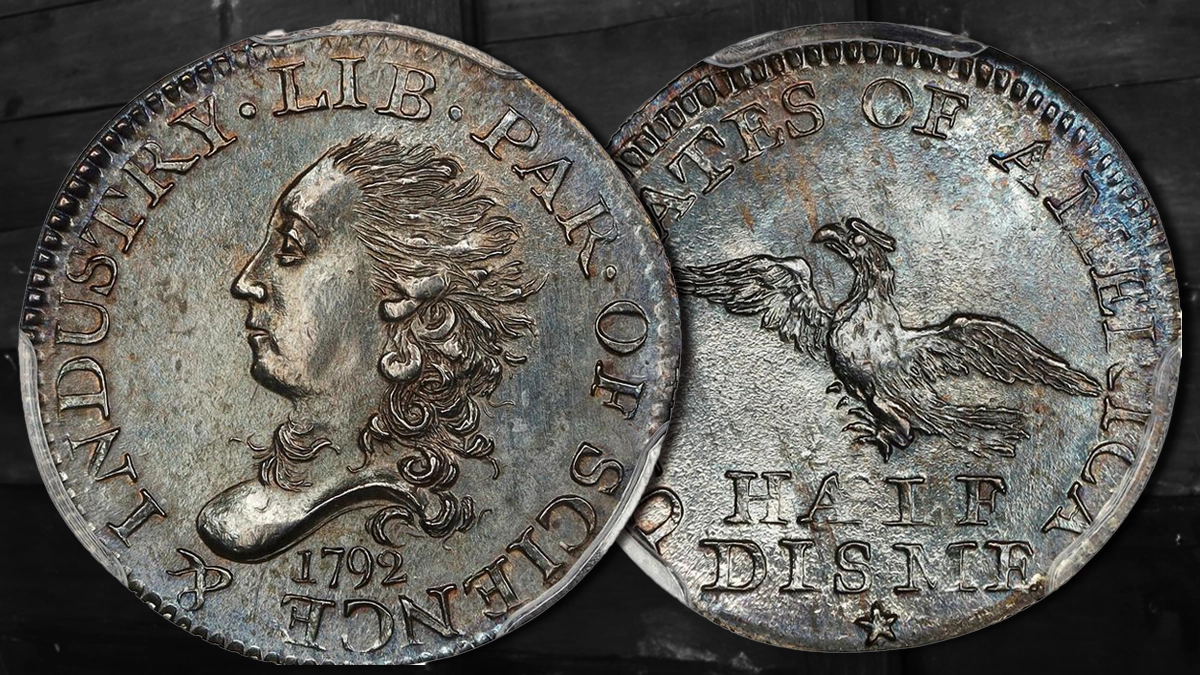
Early Attempts at a National Coinage Unsuccessful
The Coinage Act of 1792 established the United States Mint and regulated the coins of the United States, which were to based on a decimal system preferred by Thomas Jefferson and Alexander Hamilton. The two founding fathers were often on opposing sides of key issues, but they were aligned in their belief that the fledgling country needed to produce its own national coinage.
Attempts to establish a national coinage had been ongoing since before the Americans secured victory against the British in the Revolutionary War. The Continental Congress under the Articles of Confederation attempted it, going so far as to authorize the establishment of a mint, but did not fund it. Financier Robert Morris had pattern coins made as early as 1783, but these did not result in circulating coinage.
Realizing that the structure of the confederated government was ill-equipped to address the nation’s needs, a Constitutional Convention was held in 1787 and a new covenant between the states was drawn up.
The new Federal Government again took up the coin issue and contracted for the production of three hundred tons of Fugio cents. This turned into a boondoggle when only 400,000 coins were delivered (the remaining copper was used to strike 1787 Connecticut coppers, which presumably would have been more profitable for coiners James Jarvis and his father-in-law Samuel Broome. It took four years for Congress to finally authorize the construction of a national mint, appropriate the funds to buy the buildings and equipment, and hire the necessary workers.
What Is a Half Disme and Why Is It Significant?
On April 14, 1792, President George Washington appointed David Rittenhouse, a polymath and recent Treasurer of Pennsylvania, to the role of United States Mint Director. Rittenhouse was a sound choice; not only did he have strong mechanical and engineering skills, but he was also a man of action and integrity. He immediately located an acceptable property and began construction of America’s money factory.
The first Mint was to be located at 7th and Arch Streets in Philadelphia. The city was then the seat of the Federal Government and the Mint building was raised on a lot previously occupied by an abandoned whiskey distillery. Construction began July 31.
But even before the facility was ready, Rittenhouse was eager to begin operations.
In a July 9 letter, Rittenhouse seeks approval from Washington to coin half cents, cents, half dismes (pronounced “deems”), and dismes. At the time, the director had access to a press and the cellar of Philadelphia saw-maker John Harper’s Sixth and Cherry Street workshop.
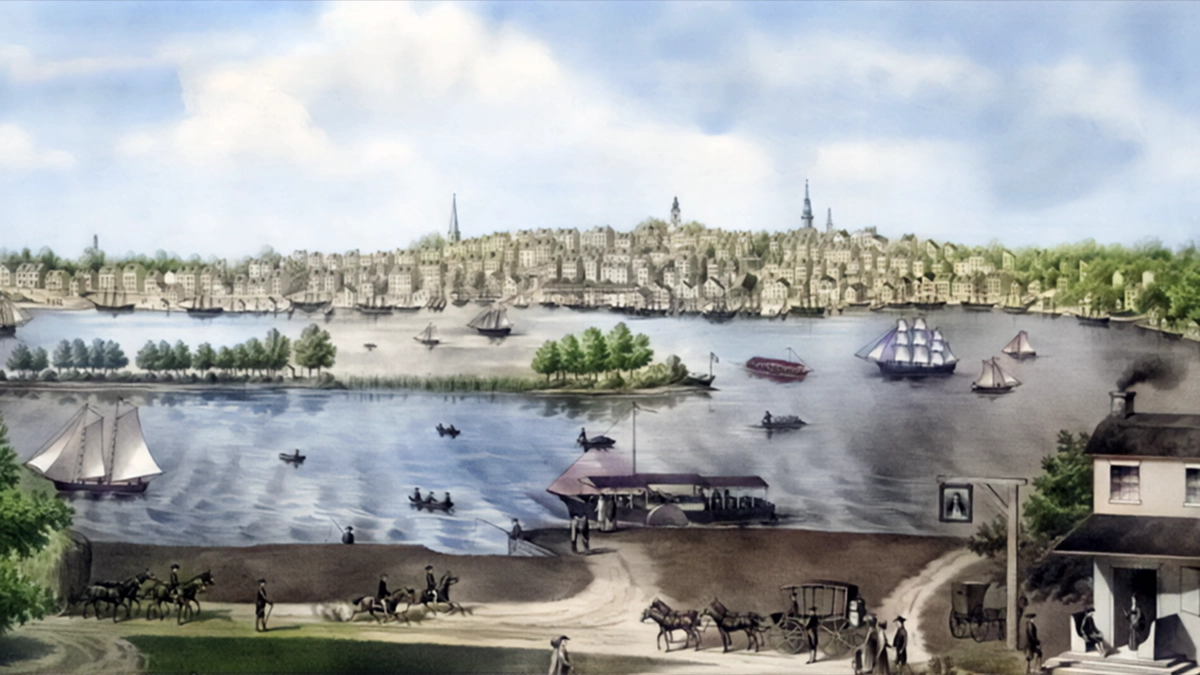
The Mint’s first depositor was Secretary of State Thomas Jefferson, who paid a visit to Rittenhouse on July 11 and ordered that his deposit of $75 dollars in silver be coined. Having dies for a five-cent denomination called a “half disme” available, Henry Voight likely struck Jefferson’s 1,500 coins.
Many examples were struck off-center, causing the dies to fail early. Die cracks appeared after the striking of a few hundred coins, and the dies progressively got worse. Nevertheless, the mintage of 1,500 pieces was struck with a single pair of dies.
Numismatic researcher and author Joel Orosz believes that a second order of half dismes was placed on October 9, and that some 500 coins were likely struck. These half dismes are distinguishable from the Jefferson strikes due to the “rough raised patches found on the reverse; either die rusting or spalling had occurred during three months of humid Philadelphia summer (Smith et al., 102).”
Research into Jefferson’s personal documents carried out by Orosz and fellow numismatists Pete Smith and Leonard Augsburger reveal that Jefferson picked up the coins on July 13, and later that day paid “servants” at a Chester, Pennsylvania inn 30 cents in the new coin. This would be the first commercial transaction of a U.S. coin struck under the authority of the United States Constitution. Smith, Orosz, and Augsburger also posit that the individuals who were paid with the new coins were likely African American. This exchange was the first of many that Jefferson made on his trip home to Monticello. Along the way, other merchants received the small silver coins.
President Washington referred to these coins in his November 6, 1792, National address:
In execution of authority given by the legislature, measures have been taken for engaging some artists from abroad to aid in the establishment of our Mint. Others have been employed at home. Provisions have been made for the requisite buildings, and these are now putting into proper condition for the purposes of the establishment. There has been a small beginning in the coinage of half dimes, the want of small coins in circulation calling the first attention to them.
With only 2,000 coins struck in 1792, and no follow-up mintage in 1793, America’s first half disme faded into obscurity.
The true origins of the half disme were unknown when Mint Director James Ross Snowden wrote of the following “history” of the coin:
The bust of Liberty is popularly supposed to represent the features of Martha Washington who is said to have sat for the artist while he was designing it … This piece is said to have been struck from the private plate of Washington, which is not unlikely, considering the great interest which he took in the operations of the infant mint, visiting it frequently, and personally superintending many of its affairs.
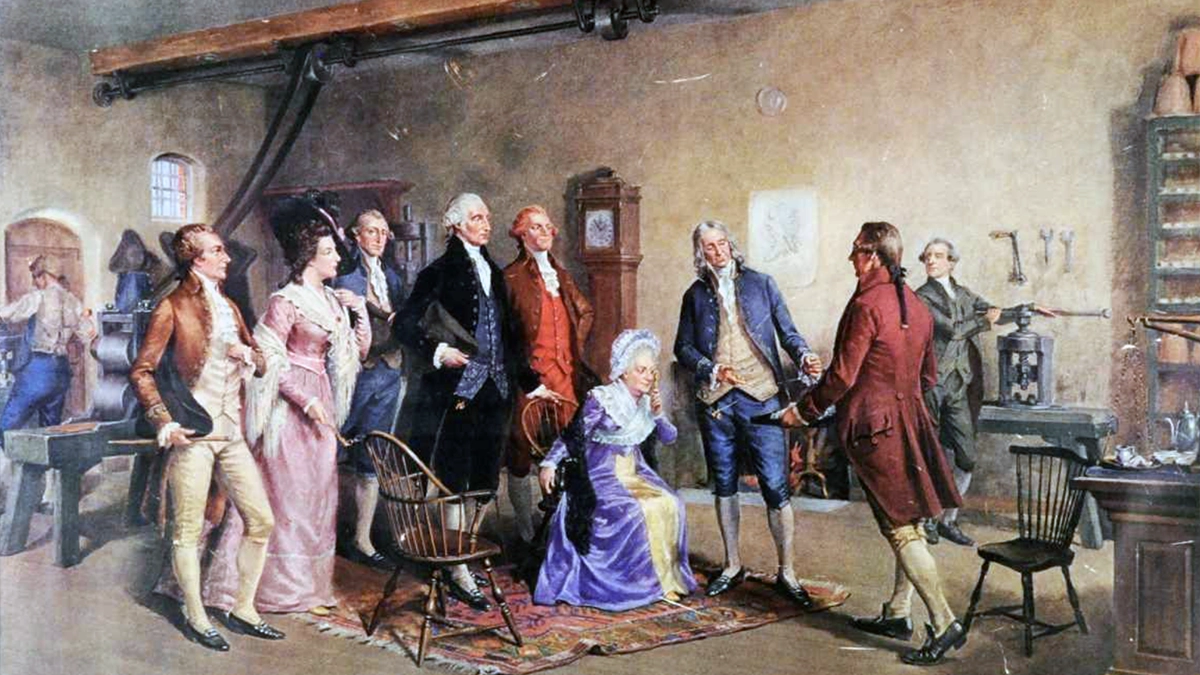
This myth was immortalized in painter John Ward Dunsmore’s Washington Inspecting the First Money Coined by the United States (1914). This counterfactual painting is on display at the Philadelphia Mint.
In 1794, half disme production would commence again at the Mint. The 1794 coin had a Flowing Hair design on the obverse and a wreath and eagle on the reverse. Nowhere was the word half “disme” inscribed. When the Draped Bust disme entered production in 1796, the word “disme” was also absent. The Coinage Act of 1837 changed the official name of the denominations to half dime and dime. For the sake of clarity, contemporary numismatic publications only refer to the 1792 half dismes and the pattern 1792 dismes as “dismes”.
The half dime served the United States as its five-cent coin until 1873. It was phased out by the five-cent nickel, which was first introduced in 1866.
Additional Exclusive CoinWeek Coverage of the 1792 Half Disme
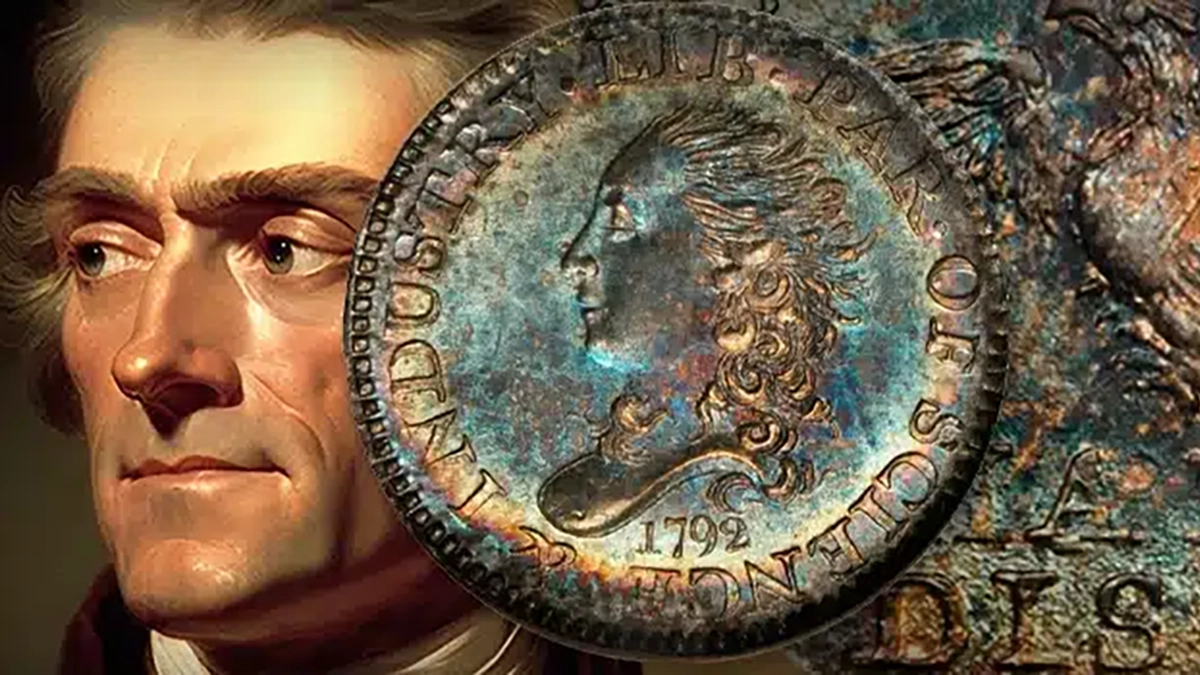
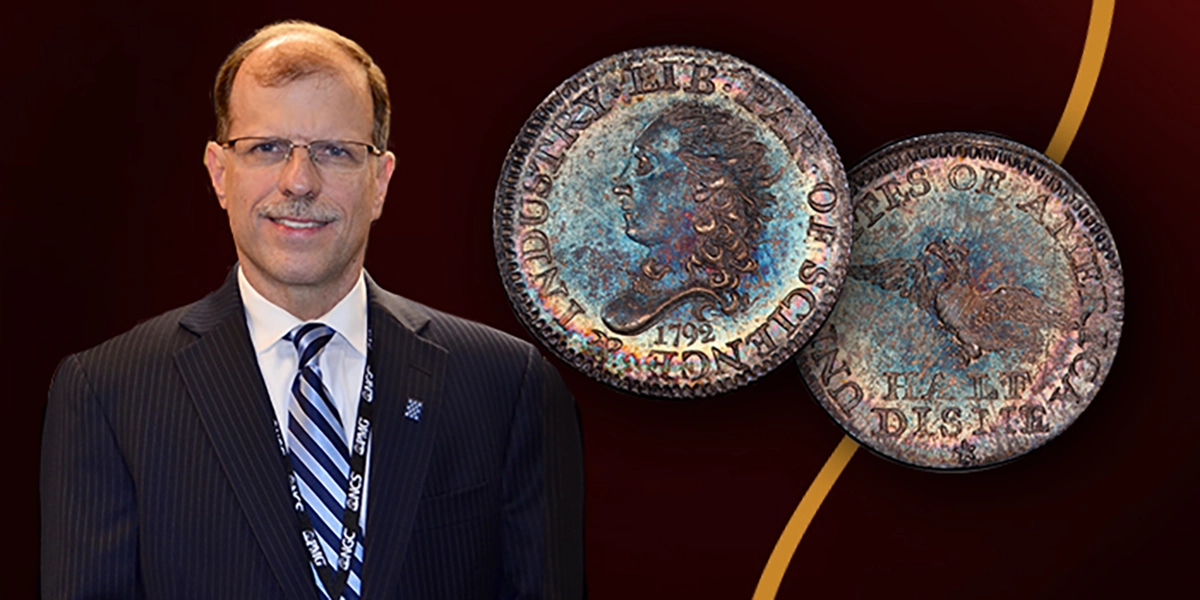
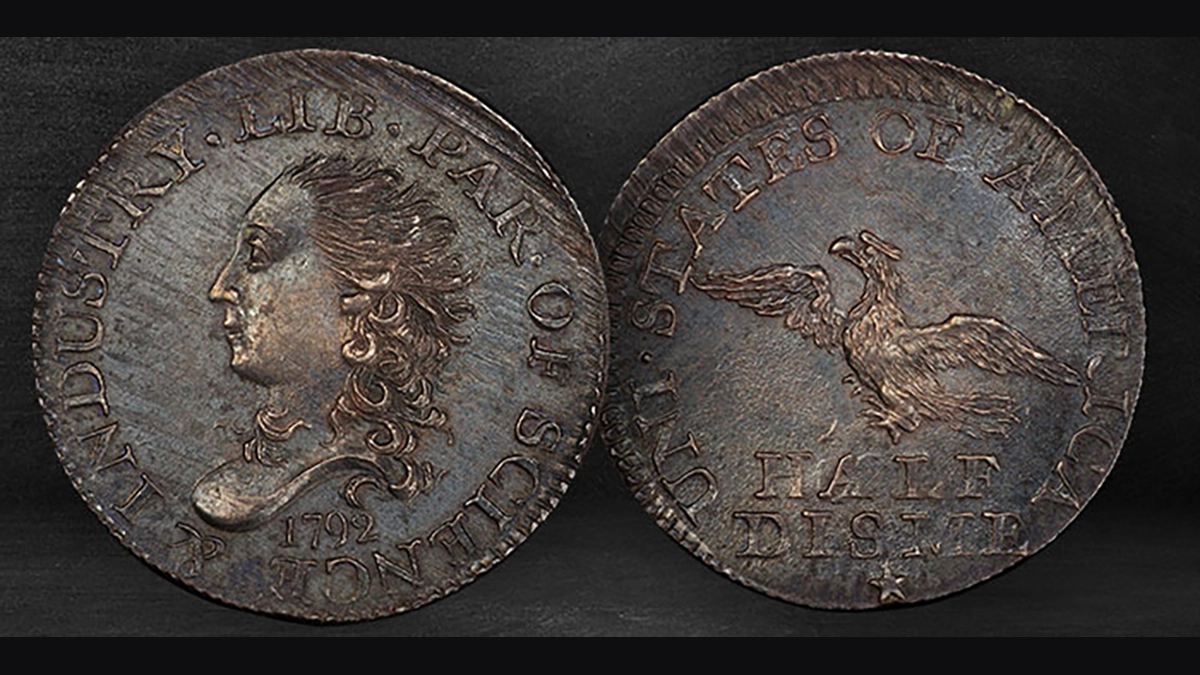
* * *
Market Data and Noteworthy Specimens
Judd-7. Pollock-7. Logan-McCloskey-1. Rarity-4. Numismatists who have studied auction and sales data, estimate that between 200 and 400 1792 half dismes exist today in all grades. For over 200 years, these coins have been among the most prized numismatic items ever issued by the United States. Of the issue, numismatist Walter Breen wrote, “Their historic context has made these half dismes among the most prized American silver coins.”
The coin was ranked #10 in Jeff Garrett and Ron Guth’s 100 Greatest U.S. Coins (5th Edition, 2019).
Top Population: PCGS MS-68 (1, 2/2024). NGC MS-65 (1, 2/2024). CAC SP-67 (1:0 stickered:graded, 2/2024).
- PCGS SP-67: “J.C. Morgenthau’s “Great American” Sale” (Virgil Brand), October 1993, Lot 77; Floyd T. Starr, October 26, 1933, via J.G. Macallister; “The Legendary Collection of Floyd T. Starr”, Stack’s, October 1992, Lot 4; Superior, July 1993, Lot 137; Heritage Auctions, April 2006, Lot 1860; “The Greensboro Collection, Part II”, Heritage Auctions, January 2013, Lot 5570. Pedigree research provided by Heritage Auctions.
- PCGS MS-68: David Rittenhouse, held be family until 1919. “ANA Convention Auction”, Henry Chapman, October 1919, Lot 249; George L. Tilden; “The George L. Tilden Collection”, Thomas Lindsay Elder, June 1921, Lot 2029; private collector; unnamed museum in New England; Stack’s, October 1988, Lot 536; unknown intermediaries; dealer Jay Parrino, early 1990s, as agent for the following; the anonymous “Knoxville Collection,” early 1990s to 2003; private collector, 2003 to January 2007; dealer Steve Contursi; January-July 2007; Cardinal Collection Educational Foundation; “The the Cardinal Collection”, Stack’s Bowers, January 2013, Lot 13093 – $1,145,625; sold in 2018 for $1,985,000 million to coin dealer Brian Hendelson. Pedigree research provided by Stack’s Bowers.
In the video below, CoinWeek’s David Lisot interviews Stack’s Bowers Galleries Director of Consignments John Pack about the January 2012 sale of the Rittenhouse specimen 1792 half disme.
- PCGS MS-66 #5062947: Dr. J. Hewitt Judd; Auction ‘80, Paramount, August 1980, Lot 592; “The Jimmy Hayes Collection of United States Silver Coins”, Stack’s, October 1985, lot 3. Stack’s Bowers, August 14, 2013, Lot 4043 – $793,125. Judd traced the coin back to Rittenhouse Beautifully toned.
- NGC MS-66: Colonel James W. Ellsworth, March 1923; John Work Garrett; “The Garrett Collection, Part IV”, Bowers and Ruddy, March 1981, Lot 2251; “Jascha Heifetz Collection”, Superior, October 1989, Lot 891; “Father Flanagan’s Boys Home Collection”, Superior, May 1990, Lot 3550; Stack’s, October 1994, Lot 267; Bowers and Merena, August 2004, Lot 1383.
- PCGS MS-66: As PCGS MS-65. “The Klamath Mountain Collection, Part II”, Heritage’s 2014, OGH (graded circa 1989) – $528,750. As PCGS MS-66. Heritage Auctions, January 2017 – $493,500.
Other Mentions
Leo Frese appeared on Cool Coins! Episode #2, where he showed off a 1792 half disme in PCGS AU-55 #16101261.
* * *
Design
Obverse:
On the obverse, a left-facing portrait of a woman. The inscription LIB PAR OF SCIENCE & INDUSTRY (“Liberty Parent of Science & Industry”) encircles the design clockwise starting from the 12 o’clock position at the rim. The date “1792” is located below the bust truncation.
Reverse:
On the reverse is an eagle with its right wing slightly raised. Encircling inscription: UNITED STATES OF AMERICA. Below the eagle is the denomination HALF DISME. A five-pointed star is below the denomination.
* * *
Coin Specifications
| Country: | United States of America |
| Year Of Issue: | 1792 |
| Denomination: | Half Disme (USD) |
| Mint Mark: | None (Philadelphia) |
| Mintage: | 2,000 (estimated) |
| Alloy: | .892 silver, .108 copper |
| Weight: | 1.35 g |
| Diameter: | 17.50 mm |
| Edge | Reeded |
| OBV Designer | Giuseppe Ceracchi (possibly) |
| REV Designer | Giuseppe Ceracchi (possibly) |
| Quality: | Business Strike |
* * *
References
Smith, Pete, Joel Orosz, and Leonard Augsburger. 1792: Birth of a Nation’s Coinage. Ivy Press (2016)
* * *




